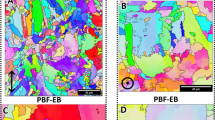Abstract
Combustion synthesis (CS) is a specific approach for fabrication of a variety of advanced materials through use of self-sustaining chemical reactions. Controlling over the microstructure of the material is a key factor in defining the maturity of a technology. In this work, we demonstrate that under specific conditions, morphology and microstructure of the initial reaction media do not change during the CS process. Thus, one may control the microstructure of CS materials by preparing the desired structure of the initial reaction media. Specifically, using examples from several systems, which include intermetallics (NiAl), ceramics (SiC) and refractory carbides (TiC), we demonstrate that combination of short-term high-energy ball milling and CS allows precise control over the morphology and phase composition of product powders.






Similar content being viewed by others
References
Merzhanov AG, Borovinskaya IP, Shkiro VM, (1984) Phenomenon of wave localization for self—retarding solid state reactions, Diploma № 287, filed 05.07.1967; Vestnik of USSR Academy of Science, 10:13–16
Merzhanov AG, Borovinskaya IP (1972) Self-spreading high-temperature synthesis of refractory compounds. Dokl Chem 204:429–431
Merzhanov AG (1990) Self-propagating high-temperature synthesis: twenty years of research and findings. In: Munir Z, Holt JB (eds) Combustion and plasma synthesis of high-temperature materials. VCH, New York, pp 1–90
Hlavacek V (1991) Combustion synthesis: a historical perspective. Am Ceram Soc Bull 70:240–243
Merzhanov AG (1995) History and recent development in SHS. Ceram Int 21:371–379
Rogachev AS, Mukasyan AS (2015) Combustion for materials synthesis. CRC Press, Taylor & Francis, Boca Raton, pp 34–38
Koch CC, Whittenberger JD (1996) Mechanical milling/alloying of intermetallics. Intermetallics 4:339–355
Koch CC (1997) Synthesis of nanostructured materials by mechanical milling: problems and opportunities. Nanostruct Mater 9:13–22
Suryanarayana C (2004) Mechanical alloying and milling. Marcel Dekker, New York, pp 183–227
Takacs L (2002) Self-sustaining reactions induced by ball milling. Prog Mater Sci 47:355–414
Maglia F, Anselmi-Tamburini U, Deidda C et al (2004) Role of mechanical activation in SHS synthesis of TiC. J Mater Sci 39:5227–5230. doi:10.1023/B:JMSC.0000039215.28545.2f
Urakaev FK, Akmalaev KA, Orynbekov ES et al (2001) The use of combustion reactions for processing mineral raw materials: metallothermy and self-propagating high-temperature synthesis (review). Metall Mater Trans B 47:56–58
Balaz P, Achimovova M, Balaz M et al (2013) Hallmarks of mechanochemistry: from nanoparticles to technology. Chem Soc Rev 42:7571–7637
Mukasyan AS, Rogachev AS, Aruna ST (2015) Combustion synthesis in nanostructured reactive systems. Adv Powder Technol 26:954–976
Rogachev AS, Mukasyan AS (2010) Combustion of heterogeneous nano-structured systems. Combust Explos Shock Waves 4:243–266
Rogachev AS, Moskovskikh DO, Nepapushev AA, Sviridova TA, Vadchenko SG, Rogachev AS, Mukasyan AS (2015) Experimental investigation of milling regimes in planetary ball mill and their influence on structure and reactivity of gasless powder exothermic mixtures. Powder Technol 274:44–52
Shuck CE, Pauls JM, Mukasyan AS (2016) Ni/Al Energetic nanocomposites and the solid flame phenomenon. J Phys Chem C 120:27066–27078
Mukasyan AS, White J, Kovalev DY, Kochetov NA, Ponomarev VI, Son SF (2010) Dynamics of phase transformation during thermal explosion in the Al–Ni system: influence of mechanical activation. Phys B Condens Matter 405:778–784
Manukyan KV, Mason BA, Groven LJ, Ya-C Lin, Cherukara M, Son SF, Strachan A, Mukasyan AS (2012) Tailored reactivity of Ni + Al nanocomposites: microstructural correlations. J Phys Chem C 116:21027–21038
Mukasyan AS (2011) Combustion synthesis of silicon carbide in a book. In: Gerhardt R (ed) Properties and applications of silicon carbide. INTECH, Vienna, pp 389–409
Mukasyan AS, Ya-C Lin, Rogachev AS, Moskovskikh DO (2013) Direct combustion synthesis of silicon carbide nanopowder from the elements. J Am Ceram Soc 96:111–117
Moskovskikh DO, Song Y, Rouvimov S, Rogachev AS, Mukasyan AS (2016) Silicon carbide ceramics: mechanical activation and spark plasma sintering. Ceram Int 42:12686–12693
Lohse BH, Calka A, Wexler D (2007) Synthesis of TiC by controlled ball milling of titanium and carbon. J Mat Sci 42:669–675
Manukyan KV, Ya-C Lin, Rouvimov S, McGinn PJ, Mukasyan AS (2013) Microstructure-reactivity relationship of Ti-C reactive nanomaterials. J Appl Phys 113:024302–024302–024302–024310
Shuck CE, Manukyan KV, Rouvimov S, Rogachev AS, Mukasyan AS (2016) Solid-flame: experimental validation. Combust Flame 163:487–493
Acknowledgements
This work was supported by the Department of Energy, National Nuclear Security Administration, under Award Number DE- NA0 0 02377. The authors also gratefully acknowledge the financial support of the Ministry of Education and Science of the Russian Federation in the framework of Increase Competitiveness Program of NUST «MISiS» (№К2-2016-065), implemented by a governmental decree dated March 16, 2013, N 211.
Author information
Authors and Affiliations
Corresponding author
Ethics declarations
Conflict of interest
The authors declare that they have no conflict of interest.
Rights and permissions
About this article
Cite this article
Mukasyan, A.S., Rogachev, A.S. Combustion synthesis: mechanically induced nanostructured materials. J Mater Sci 52, 11826–11833 (2017). https://doi.org/10.1007/s10853-017-1075-9
Received:
Accepted:
Published:
Issue Date:
DOI: https://doi.org/10.1007/s10853-017-1075-9




